PKU News: Prof. Yu Kongjian wins 2023 Cornelia Hahn Oberlander International Landscape Architecture Prize
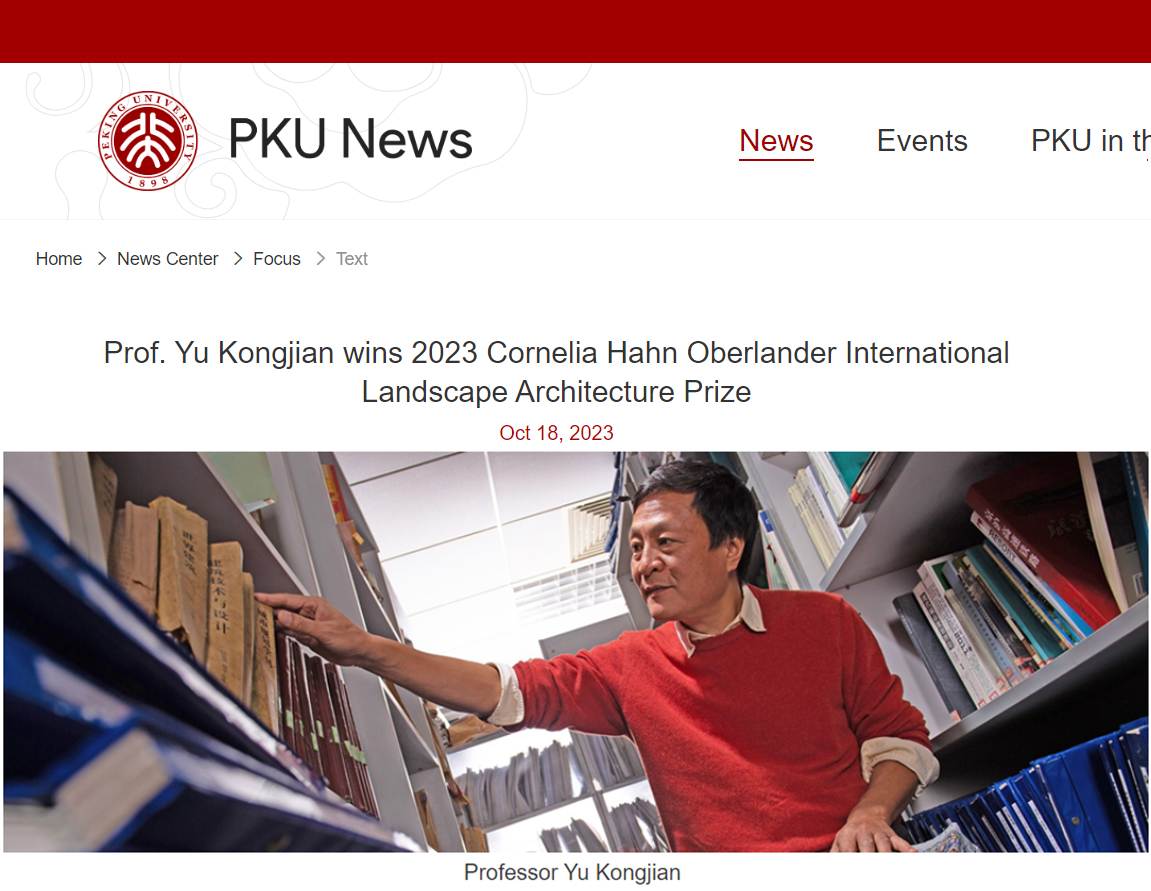
Washington, D.C., Oct. 17 (Peking University) – The Cultural Landscape Foundation (“TCLF”) on Oct. 17 (EST) announced that Professor Yu Kongjian, from Peking University’s College of Architecture and Landscape Architecture, was the recipient of the 2023 Cornelia Hahn Oberlander International Landscape Architecture Prize (“Oberlander Prize”).
The biennial Oberlander Prize is bestowed on a recipient who is “exceptionally talented, creative, courageous, and visionary” and has “a significant body of built work that exemplifies the art of landscape architecture.” Yu was selected by an international seven-person jury, supported by Oberlander Prize Curator John Beardsley, from more than 300 nominations worldwide. The Oberlander Prize Jury Citation noted that Yu is a “brilliant and prolific designer … [who] is also a force for progressive change in landscape architecture around the world.”
“He lives and breathes his conviction that landscape architecture is the discipline to lead effective responses to the climate crisis,” said TCLF President & CEO Charles A. Birnbaum, “and his ideas are inspiring planners and decision-makers in Australia, Bangladesh, Canada, Denmark, Egypt, England, India, Indonesia, Kenya, Mexico, The Netherlands, New Zealand, Russia, Singapore, South Africa, Sweden, and elsewhere.”
Prof. Yu's “sponge cities” concept addresses climate change-accelerated urban flooding with large-scale nature-based infrastructure – including constructed wetlands, greenways, parks, canopy tree and woodland protection, rain gardens, green roofs, permeable pavements, bioswales, other measures – that acts as sponges soaking up and storing rainfall instead of relying primarily on traditional concrete reinforced riverbanks, dams, pipes, drains, and other conventional engineering solutions.
Since being adopted as a national policy in 2014, more than 70 cities in China have implemented the “sponge cities” concept with the goal that, by 2030, 80% of the cities would be able to absorb 70% of their rainfall.
To date Yu and his firm have some 600 built projects in more than 200 cities, principally in China, but also in Thailand, and the U.S.
Notable projects include the following:
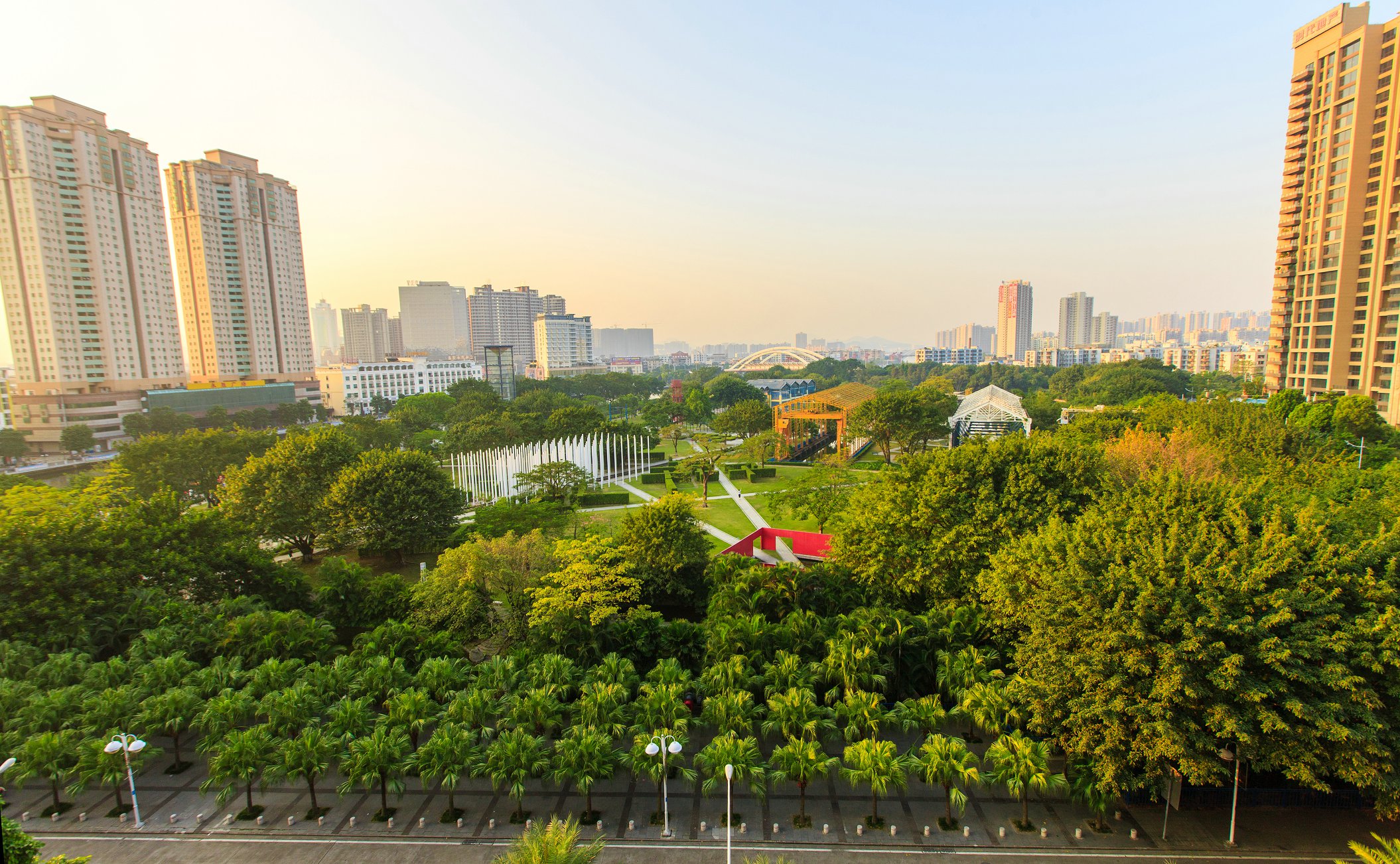
Zhongshan Shipyard Park, Zhongshan, Guandong Province, 2001. A 27-acre park built on the site of a 1950s shipyard that went bankrupt in 1999. Instead of razing the culturally significant site, the design, an early example of the “sponge cities” concept, retained some of the extant vernacular architecture, along with machines, docks, and other industrial structures that were repurposed. Yu believes in the retention of cultural landscape heritage, including industrial sites and working landscapes.
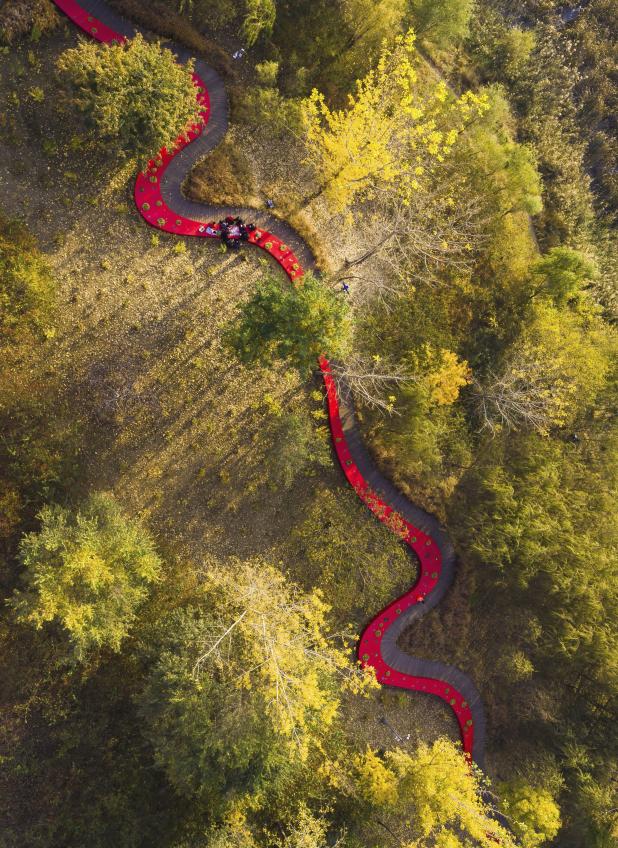
Red Ribbon Park, Qinhuangdao, Hebei Province, 2007. The principal design element is an eye-catching yet minimal intervention – a surgically-inserted, sinuous 1,640-feet-long (500-meter) red benchlike structure threaded along the length of a narrow rectangular park on the Tanghe River. It integrates a boardwalk, seating, and lighting; lit from inside, it glows red at night. The park retained the site’s lush and diverse native vegetation, eliminated dumped garbage, and provided scenic and recreational opportunities.
Shanghai Houtan Park, Shanghai, 2010. This narrow liner 34.6-acre (14-hectare) park, with a mile-long constructed wetland, was created on a former industrial site located along the Huangpu River waterfront. The wetlands control flooding and help cleanse polluted water. Reclaimed industrial structures and materials are woven into a pedestrian network composed of a main loop, a series of perpendicular roads bisecting the wetland, and an array of footpaths leading through the site's terraces.
The Qunli Stormwater Park, Qunli New District, Harbin City, Heilongjiang Province, 2011. One of the first “sponge cities” projects to gain wide attention, this 80-acre (34.2-hectare) national urban wetland park was created from a dying wetland. The park features a series of ponds and mounds with native grasses, meadows, and silver birch trees that create a dense forest setting. A series of pathways and elevated walkways ring the park and include multiple viewing opportunities including elevated platforms and towers.
Sanya Mangrove Park, Sanya, Hainan Province, 2016. A lush and biodiverse mangrove park along the Sanya River measuring 24.7 acres (ten hectares) was sculpted from a trash-strewn landfill with concrete flood walls. The site was sculpted into a series of finger-like landforms, with skywalks connecting with pathways that lead to elevated pavilions, which afford multiple viewing opportunities.
Sanya Dong'an Wetland Park, Sanya, Hainan Province, 2016. One of the earliest and the most significant demonstration and multi-functional projects of the nationwide sponge city effort. The 168-acre (68-hectare) site was transformed from a polluted wetland on a river corridor that had been filled with urban debris. The new park design integrates wetlands, ponds, rice paddies, greenways, and coastal habitats into a holistic sponge system to retain, cleanse water and recharge the aquifer. This green infrastructure also integrates interconnected pedestrian and bicycle paths that provide freedom of movement throughout the park.
Nanchang Fish Tail Park, Nanchang, Jiangxi Province, 2022. A 126-acre (51-hectare) floating forest in the provincial capital reclaimed a polluted former fish farm and coal ash dump site. Dozens of small islands planted with dawn redwood and two types of cypress, some of which are ringed by giant stands of yellow irises, help regulate stormwater, provide habitat for wildlife, and offer an array of scenic and recreational opportunities. A network of walkways connects to bridges, platforms, pavilions, and viewing towers that are strategically placed to key vistas and focal points.
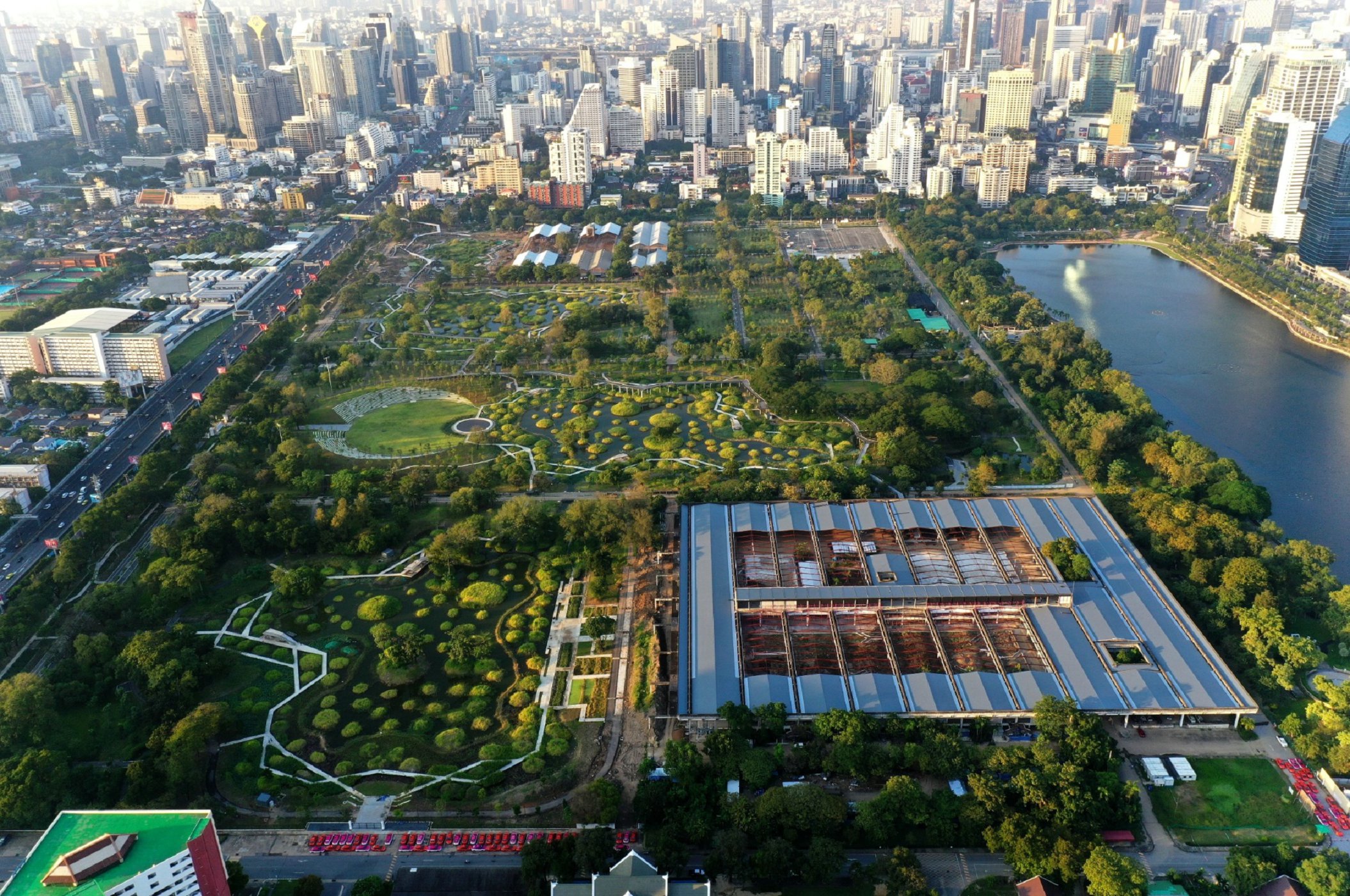
Benjakitti Forest Park, Bangkok, Thailand, 2023. This 102-acre (41.3-hectare) park at a former tobacco factory with numerous single-story warehouses was transformed into the largest public recreational space for residents of downtown Bangkok and its environs in just eighteen months. In constructing the park, extant trees were retained and integrated into the new design, while several vernacular warehouses were repurposed. Three newly constructed wetlands feature hundreds of small islands that provide habitat and manage stormwater.
Prof. Yu's built projects in the U.S.:
Chinatown Park, Boston, MA, USA, 2007. A joint project with Boston-based CRJA, (now IBI Group) the roughly three-quarter-acre (.3-hectare) site was one of 45 parks and public plazas that resulted from the Central Artery/Tunnel Project, known as the Big Dig, which replaced a deteriorating elevated six-lane highway with an underground tunnel route. The arced rectangular-shaped park that replaced a former off-ramp features a serpentine path lined on both sides by low stone benches that terminates in an open, multi-purpose gathering space.
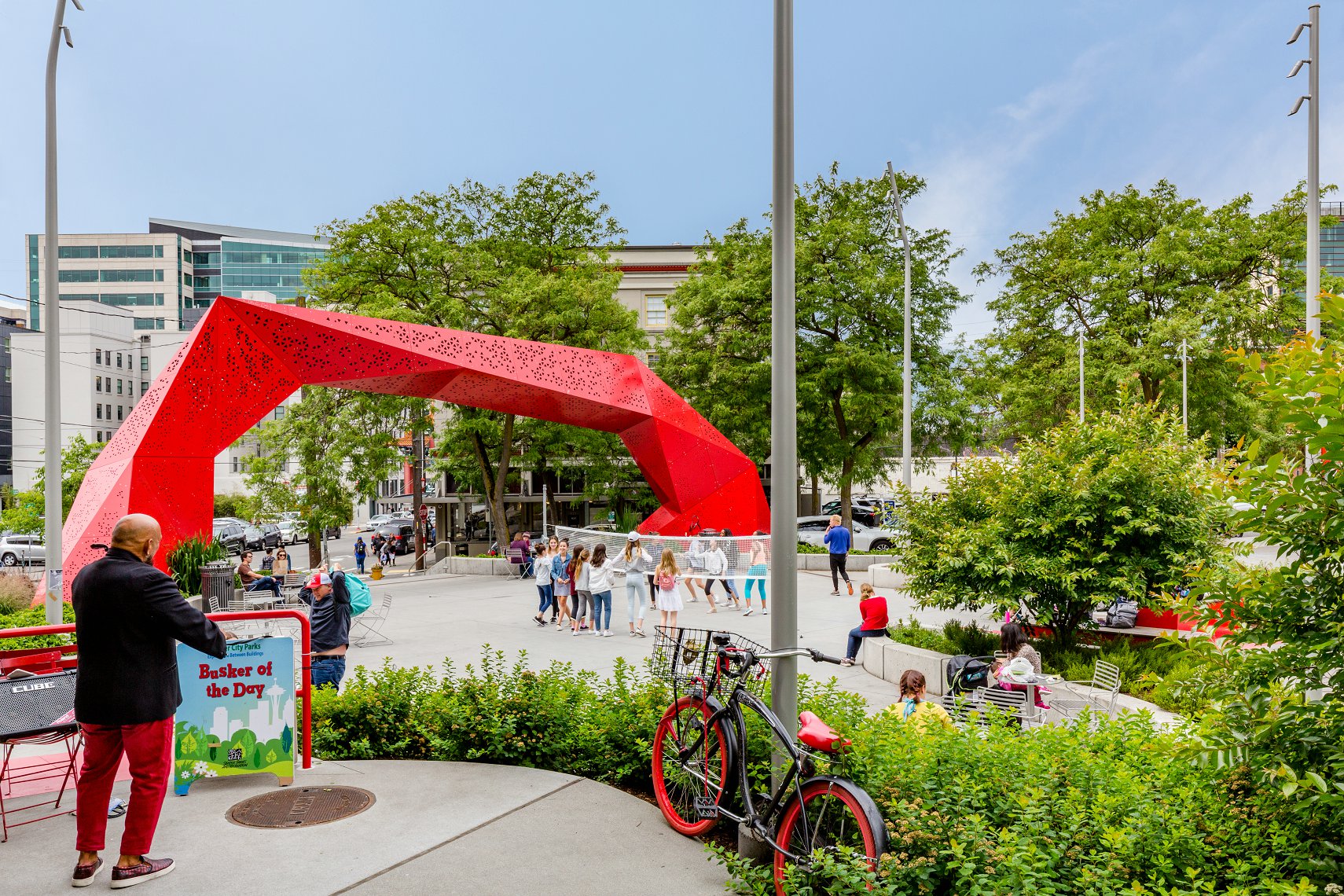
Hing Hay Park, Seattle, WA, 2018. The dominant feature of this two-third-acre (.27-hectare) park in the heart of the Chinatown-International District Neighborhood is a twenty by 70-foot angular perforated red metal gateway inspired by Asian paper cutting and folding traditions. A project with Seattle-based SvR Design Company (now MIG | SvR), the site includes multiple garden terraces, inspired by the rice paddies of Yu’s agrarian upbringing, and numerous gathering and performance spaces. The plant materials include Chinese natives such as white crape myrtle and lacebark.
As an Oberlander Prize laureate, significant built works by Yu will be added to TCLF’s What’s Out There® database, which currently features more than 2,700 sites, 15,000 images, and 1,100 designer profiles. As with the inaugural laureate, Julie Bargmann, Yu will also be the subject of a forthcoming Pioneers video oral history. His work and design philosophies will also serve as the curatorial inspiration for public engagement activities that will take place beginning in 2024.
About the Oberlander Prize
The biennial Cornelia Hahn Oberlander International Landscape Architecture Prize, which includes a $100,000 award and two years of public engagement activities, was created to increase the visibility, understanding, appreciation, and conversation about landscape architecture. The New York Times recognized Cornelia Hahn Oberlander, the prize’s namesake, as the “grande dame of landscape architecture” and reported she was “one of the first landscape architects to speak passionately about climate change and was an early adopter of storm-water-management systems and green roofs.”
Creation of the Oberlander Prize began in 2014 amid TCLF’s efforts to prevent the demolition of the Frick Collection’s Russell Page-designed viewing garden on East 70th Street in New York City. “A lead million-dollar gift by TCLF Board Member Joan Shafran and her husband Rob Haimes, turned a dream into a possibility,” according to TCLF’s Birnbaum. “Financial support from additional donors,” he added, “including members of the 100 Women Campaign, along with key strategic advice from Jill Magnuson and other senior leadership at the Nasher Sculpture Center and Martha Thorne, former Executive Director of the Pritzker Prize, among others, helped the possibility become a reality.” The inaugural laureate, landscape architect Julie Bargmann, was announced on Oct. 14, 2021.
Oberlander Prize Jury
The seven-member jury includes leading landscape architects, urban planners, architects, academics, and other experts from around the world: Jury Chair, Elizabeth Mossop, Dean of the University of Technology Sydney School of Design, Architecture and Building (Australia); Christian Benimana, Co-Executive Director and Senior Principal, MASS Design Group (Rwanda); Consuelo Bravo, owner of Panorama (Chile); Adriaan Gueze, Founder of West 8 urban design & landscape architecture (The Netherlands); Leonard Ng Keok Poh, Ramboll Studio (Singapore); Kotchakorn Voraakhom, CEO and Founder of Landprocess and Porous City Network (Thailand); Jane Wolff, from University of Toronto (Canada).
About the Cultural Landscape Foundation
The Cultural Landscape Foundation (TCLF), founded in 1998, is a non-profit founded in 1998 to connect people to places. TCLF educates and engages the public to make shared landscape heritage more visible, identify its value, and empower its stewards. Through its website, publishing, lectures, and other events, TCLF broadens support and understanding of cultural landscapes. TCLF is also home to the Cornelia Hahn Oberlander International Landscape Architecture Prize.
Source: https://newsen.pku.edu.cn/news_events/news/focus/13692.html
